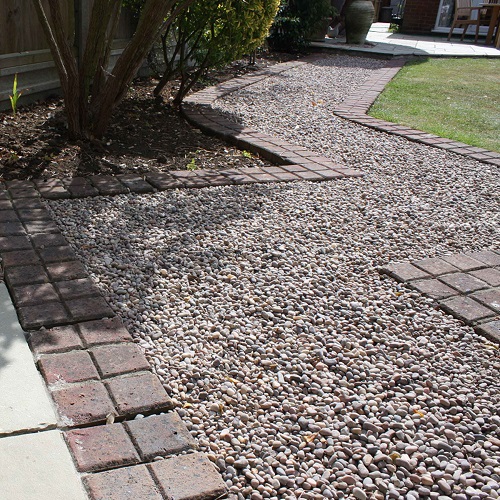Designing Your Perfect Garden Path

Although we are still in the Winter months now is the perfect time to plan your gardening activities for the Spring/Summer season. Walkways and paths are an integral part of any garden and can make a huge impact to your current landscape. If you are looking to add in a new garden pathway or perhaps update an existing pathway in your garden it takes careful planning. In this guide we hope to offer you helpful advice and tips which will make you fully prepared so when it does come to spring you can go straight ahead with installing your new path.
The Benefit to a garden pathway:
Garden pathways have many benefits however the most obvious has to be that it provides a primary sturdy surface that will allow you to access all parts of your garden. Without a walkway foot traffic would erode the ground/ grass and eventually you would have a path of mud. This can make your garden look very unattractive. Other benefits to having a garden pathway include the following:
• Help you to define all flower beds and borders
• You can help keep foot traffic off your lawn and other areas of your garden
• They can really add an impact to your garden (especially if you are creative with your design and material you select)
• They introduce another type of material to your garden this can break up your garden nicely
How to design your garden pathway:
Many gardeners and homeowners do not put a great deal of thought into their pathway and therefore miss an opportunity to be creative with their landscape. Your first job is to consider what the aim of the garden pathway is. Are you wanting to stop people from stepping on your grass? Or perhaps you are simply wanting to add an aesthetic feature to your landscape. Either way you must have a clear aim of your intention for your garden path.
Once you have established the intent of the garden path we would suggest you lay it out. This will help you gain a better idea of how it will look in your garden. You can use a hose pipe as a starting point to help lay your path out. Consider the width of you path also, if the aim of your path is to direct foot traffic perhaps you may want it a little wider to ensure you don’t get anyone stepping onto your grass. Garden paths can also be narrow, however it depends entirely on your personal preference and the aim of your walkway. Many garden paths look better if they have curves as this adds a nice decorative touch to the garden.
When considering the installation of your garden path you may find it beneficial to use a gravel paving grid. Paving grids provide ground stabilisation and are ideal if you are wanting to stabilise a range of surfaces including loose gravel. If you were looking to create a garden path which is going to see a lot of foot traffic using a paving grid will ensure your path remains secure and all gravel will remain level. Paving grids are extremely easy to install and will provide you with a guidance of the amount of gravel which you will require for your path. At Gravelmaster we sell high quality Hexapath which comes in a range of green and black, these are ideal and will complement any garden landscape.
Things to keep in mind when designing your walkway:
• Be aware of the space in your garden. Your garden path is going to divide your garden up in some way. Make sure that your path divides your garden up in a way which isn’t going to look awkward when you look at your landscape as a whole.
• Always keep your aim in mind. If you are creating a scenic pathway include numerous curves. However if your walkway is for practical purposes perhaps consider a wider walkways with less curves.
• Make sure your path complements your current landscape design. The lines of you walkways should be similar to the lines of your garden. Steer clear of dramatic circles or straight line walkways unless they will fit seamlessly into your current landscape design.
Selecting the right material:
There are several materials which are available to use for your garden pathways. Generally for garden pathways loose gravel and playbark are ideal as they can create a stunning feature in your garden and are fairly hardwearing. You can be creative with your materials and use a combination of garden slabs along with loose gravel if you wish. This is your opportunity to become creative! Below we have listed some materials that are ideal for creating garden pathways:
Gravel: Gravel is an extremely popular material used for garden pathways and driveways. Gravel is extremely easy to lay and can easily be raked into position. If you are short on time and want to get a garden pathway installed quickly this may be your better option. We would recommend our Cotswold chipping, this is a stunning crisp angular gravel that would be ideal for garden pathways and would help brighten up your current landscape. Our Cotswold chippings are also available in a range of sizes; 6mm, 10mm and 20mm.
Pebbles: Garden Pebbles are another popular material for garden paths. You are able to buy pebbles in a range of sizes and styles which makes this material ideal if you are looking to be creative. We would recommend that you use pebbles no larger than 20mm as otherwise these would not be suitable for walking on. We would recommend our Scottish pebbles 14-20mm that offer beautiful colours from sparking white to jade black. Our Scottish pebbles come in a variety of sizes and each offer perfectly smooth spheres.
Decorative Gravel: Available in a wide range of colours and types you can be selective and choose one that is either going to complement your current garden design or one that is going to stand out and make an impact. These gravels are extremely easy to lay, ideal if this is your first attempt at a garden pathway. At Gravelmaster we have a wide range of decorative gravel available in a range of colours and styles. From beautiful red granite to stunning moonstone gravel our decorative gravel will add a touch of colour to your garden.
Slate: Slate chippings offer an alternative to the more traditional gravel and cobbles. Slate is hardwearing and extremely durable making it ideal for both decorative and practical garden paths. Slate chippings are the most stylish material you could use for your garden pathways. At Gravelmaster we have a wide range of crushed slate chippings available in a range of stunning colours from deep plum to charming blue.
Ornamental Playbark: Ornamental playbark is the perfect material for pathways. It will blend beautifully into your current garden design whilst also providing you with a sturdy pathway. Ornamental playbark is a fantastic alternative to your lawn and can provide a practical solution for any garden. We would recommend our high quality playbark, this is extremely hardwearing and is a stunning dark golden brown colour.
Paving Slabs: Paving slabs are a great all year round alternative for your garden pathway. They can be used on your lawn or used with gravel. The paving slab can sit nicely on top of gravel and stones to make a useful stepping stone pathway in your garden.
We have featured one of our customer gardens who created a beautiful garden path using our beautiful Scottish Pebbles 8-14mm.
We hope this guide can been helpful and inspires you with the design of your own garden path. A quick final tip, once you have installed your pathway plant some flowers either side to create a dramatic focal point in your garden!
Below is a photograph sent in from one of our customers who has used our beautiful Scottish Pebbles to create a wonderful garden path.





